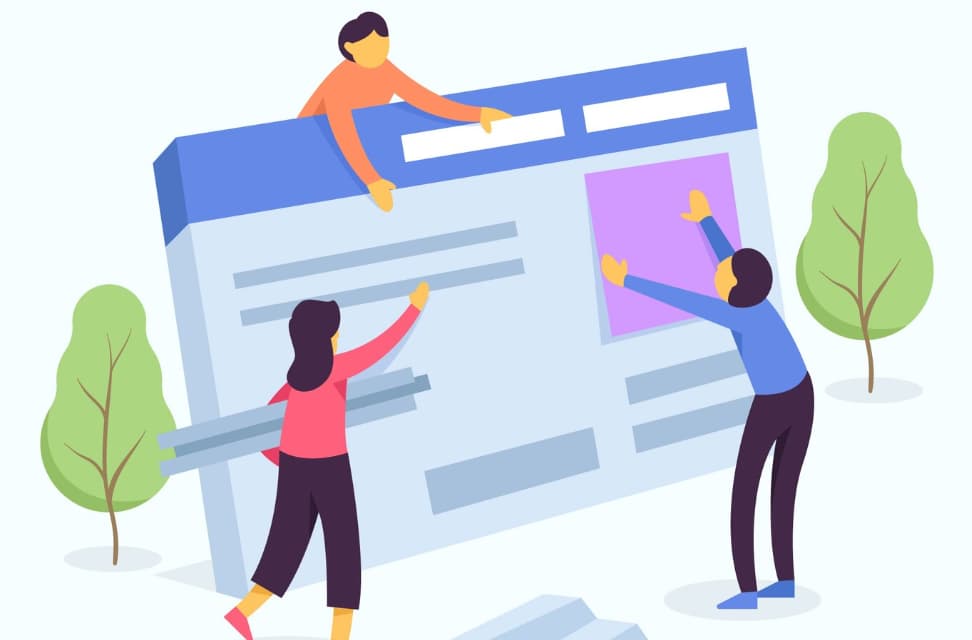In today’s digital world, your website is often the first thing people see when they learn about your business. It’s like your online storefront.
Just like you’d update a physical store to keep it fresh and appealing, websites need updates too. This is called a website redesign.
But how much does it cost to give your website a makeover in 2024? That’s what we’re going to talk about in this guide.
We’ll look at different types of redesigns, why you might need one, and what factors affect the price.
How Much Does It Cost to Redesign a Website?

We’ll also share some tips on how to plan your budget and choose the right people to help you.
Whether you’re running a small business or a big company, this guide will help you understand website redesign costs.
Let’s dive in!
What is a Website Redesign?
Before we talk about costs, let’s make sure we’re on the same page about what a website redesign is.
Definition of Website Redesign
A website redesign is when you make big changes to how your website looks, works, or both. It’s more than just changing a few colors or updating some text. A redesign can involve:
- Changing how the website looks.
- Making it easier for visitors to use.
- Adding new features.
- Improving how fast the website loads.
- Make sure it works well on phones and tablets.
- Updating the content to be more helpful or interesting.
Why Do Websites Need Redesigns?
Websites need redesigns for many reasons:
- They look old and outdated.
- They don’t work well on mobile devices.
- They’re slow to load.
- They’re hard for visitors to use.
- They’re not bringing in enough customers or sales.
- The business has changed and the website doesn’t reflect that anymore.
A good redesign can fix these problems and help your business grow.
Types of Website Redesigns and Their Costs
Not all website redesigns are the same. There are different levels, depending on how much you want to change. Let’s look at the main types:
1. Redecoration
This is the simplest type of redesign. It’s like giving your website a new coat of paint.
What it involves:
- Updating colors and fonts
- Changing images
- Tweaking the layout a bit
Cost: $1,000 – $5,000
2. Rewire
This type of redesign goes a bit deeper. It’s like rearranging the furniture in your house.
What it involves:
- Everything in a redecoration
- Changing how pages are organized
- Improving how visitors move through the site
- Minor updates to content
Cost: $5,000 – $15,000
3. Remodel
A remodel is a bigger project. It’s like knocking down a few walls in your house to create a new layout.
What it involves:
- Everything in a rewire
- Major changes to the design
- Adding new features or functionality
- Updating most of the content
Cost: $15,000 – $50,000
4. Rebuild
This is the most extensive type of redesign. It’s like tearing down your old house and building a new one from scratch.
What it involves:
- Starting over with a completely new design
- Building new features and functionality
- Creating all new content
- Often includes a new strategy for the website
Cost: $50,000 – $100,000+
Remember, these are just rough estimates. The actual cost can vary a lot depending on your specific needs and who you hire to do the work.
Common Reasons to Redesign Your Website
Now that we know the types of redesigns, let’s look at why you might need one. Here are some common reasons:
1. High Bounce Rate
The bounce rate is the percentage of visitors who leave your site after viewing just one page. If this number is high, it might mean:
- Your website is confusing
- It’s not what visitors expected
- It’s slow to load
- It doesn’t look trustworthy
A redesign can fix these issues and keep visitors on your site longer.
2. Poor Communication or Low Conversion Rate
If your website isn’t turning visitors into customers, it might be because:
- Your message isn’t clear
- It’s hard for visitors to take action (like buying a product or contacting you)
- The design doesn’t build trust
A good redesign can make your message clearer and make it easier for visitors to do what you want them to do.
3. Slow Site Speed
If your website takes too long to load, visitors might leave before they even see it. A redesign can make your site faster by:
- Optimizing images
- Improving the code
- Using better hosting
Learn to Improve Your Website’s Speed and Performance
4. Lack of Results or Conversions
If your website isn’t helping your business grow, a redesign might be needed. This could involve:
- Changing how you present your products or services.
- Making it easier for visitors to contact you or make a purchase.
- Improving how you show up in search engine results.
When Should You Redesign Your Website?
Knowing when to redesign your website is just as important as knowing how. Here are some signs it might be time for a redesign:
Signs It’s Time for a Redesign
- Your website looks outdated: Design trends change fast. If your site looks like it’s from 2010, it’s probably time for an update.
- It’s not mobile-friendly: More people browse on phones than on computers now. If your site doesn’t work well on mobile, you’re losing visitors.
- Your business has changed: If you’ve added new products or services, or if your brand has evolved, your website should reflect that.
- You’re not getting enough leads or sales: If your website isn’t helping your business grow, a redesign might help.
- It’s hard to update: If you struggle to make simple changes to your site, a new design with a better content management system could help.
- Your competitors’ sites look better: If other businesses in your industry have more modern, user-friendly sites, you might need to catch up.
How Often Should You Redesign?
There’s no hard and fast rule, but here are some guidelines:
- Small updates: Every 6-12 months
- Moderate redesign: Every 2-3 years
- Major overhaul: Every 3-5 years
Remember, these are just guidelines. The right time to redesign depends on your specific situation and how fast your industry changes.
Factors Influencing Website Redesign Costs
Now that we know why and when to redesign, let’s look at what affects the cost. Understanding these factors can help you budget better.
1. Website Size
The number of pages on your website affects the cost. More pages mean more work. Here’s a rough guide:
- Small website (1-10 pages): $1,000 – $10,000
- Medium website (10-50 pages): $10,000 – $50,000
- Large website (50+ pages): $50,000 – $100,000+
2. Complexity of the Website
A simple blog is easier to redesign than an online store with hundreds of products. Complex features like user accounts, payment systems, or custom calculators add to the cost.
3. Complexity of the Design
A basic design with standard layouts will cost less than a unique, creative design with custom illustrations or animations.
4. Functionality Requirements
The more your website needs to do, the more it will cost. For example:
- Contact forms: $100 – $500
- E-commerce functionality: $5,000 – $20,000
- User accounts: $2,000 – $10,000
- Custom calculators or tools: $1,000 – $5,000 per tool
5. Integrations Needed
If your website needs to connect with other systems (like your inventory management or customer relationship management software), this adds to the cost.
6. Content Creation and Migration
Creating new content or moving content from your old site to the new one takes time and effort. This can include:
- Writing new text
- Taking new photos
- Creating videos
- Moving and organizing old content
The cost depends on how much content you need and who creates it.
Advanced Factors Affecting Website Redesign Pricing
Beyond the basics, some more advanced factors can influence the cost of your website redesign:
1. Marketing Considerations
A good redesign doesn’t just make your site look pretty. It should also help you reach your business goals. This might involve:
- Search Engine Optimization (SEO): Making sure your site shows up in search results
- Conversion Rate Optimization (CRO): Designing your site to turn more visitors into customers
- Brand messaging: Making sure your site communicates your brand clearly
These elements can add $1,000 – $10,000 or more to your redesign cost.
2. Technical SEO Implementation
This goes beyond basic SEO. It involves making sure your site is set up in a way that search engines can easily understand. This might include:
- Setting up proper URLs
- Creating a sitemap
- Implementing schema markup
Expect to add $1,000 – $5,000 for thorough technical SEO.
3. UX Copywriting
This is about writing text that’s not just informative, but also guides users through your site and encourages them to take action. Good UX copywriting can:
- Make your site easier to use
- Increase how long visitors stay on your site
- Improve your conversion rate
Professional UX copywriting can add $1,000 – $10,000 to your redesign cost, depending on how much content you need.
Breakdown of Costs for Different Redesign Approaches
Let’s look at some examples of what you might pay for different types of redesigns:
1. Basic Redesign (Redecoration)
- New theme or template: $500 – $2,000
- Custom color scheme and font selection: $500 – $1,000
- Basic content updates: $500 – $2,000
- Total: $1,500 – $5,000
2. Moderate Redesign (Rewire/Remodel)
- Custom design: $5,000 – $15,000
- Development and CMS integration: $3,000 – $10,000
- Content creation or major updates: $2,000 – $10,000
- New features or functionality: $2,000 – $10,000
- SEO optimization: $1,000 – $5,000
- Total: $13,000 – $50,000
3. Complete Overhaul (Rebuild)
- Strategy and planning: $5,000 – $15,000
- Custom design: $15,000 – $30,000
- Development of complex functionality: $20,000 – $50,000
- Extensive content creation: $10,000 – $30,000
- Advanced SEO and marketing integration: $5,000 – $15,000
- Testing and quality assurance: $5,000 – $10,000
- Total: $60,000 – $150,000+
Remember, these are rough estimates. Your actual costs may be different based on your specific needs and who you hire to do the work.
Choosing a Web Design Agency
When it’s time to redesign your website, you have several options for who can do the work. Let’s look at the main choices:
1. Local US Agency
Pros:
- Easy to communicate with
- Understand the local market and culture
- Can meet in person if needed
Cons:
- Usually the most expensive option
- May have longer wait times due to high demand
Cost: $100 – $250+ per hour
2. Overseas Agency
Pros:
- Often much cheaper
- Can work while you sleep due to time differences
Cons:
- Potential language and cultural barriers
- Time zone differences can make communication harder
Cost: $25 – $100 per hour
3. Freelancers
Pros:
- Can be very cost-effective
- Often specialize in specific areas
Cons:
- May not have all the skills needed for a full redesign
- Can be less reliable than established agencies
Cost: $50 – $200+ per hour, depending on experience and location
4. DIY Website Builders
Pros:
- Cheapest option
- Can make changes whenever you want
Cons:
- Limited design options
- Requires your time and effort
- May not look as professional
Cost: $0 – $500 per year for the platform, plus your time
The best choice depends on your budget, how complex your redesign is, and how much time you can invest. Many businesses use a mix of these options. For example, you might hire a local agency for strategy and design, but use overseas developers for coding.
How to Budget for Your Website Redesign?
Planning your budget for a website redesign can be tricky. Here are some steps to help:
-
1. Determine Your Needs and Priorities
Make a list of what you want your new website to do. Sort this list into “must-haves” and “nice-to-haves”. This will help you focus your budget on what’s most important.
-
2. Research Costs
Look at the prices different agencies and freelancers charge. Get quotes for your specific project. This will give you a realistic idea of costs.
-
3. Consider the Return on Investment (ROI)
Think about how a better website could help your business. Could it bring in more customers? Save you time? Make more sales? This can help you decide how much to invest.
-
4. Plan for Unexpected Costs
It’s smart to add 10-20% to your budget for unexpected expenses. Website projects often have surprises.
-
5. Think Long-Term
Consider ongoing costs like hosting, maintenance, and updates. A cheap redesign might cost you more in the long run if it needs lots of fixes.
Cost-Saving Strategies
If you’re on a tight budget, here are some ways to save money:
- Start with a template: Using a pre-made design template is much cheaper than a custom design.
- Limit custom features: Each custom feature adds to the cost. Stick to the basics if you’re on a budget.
- Provide your content: Writing content and taking photos yourself can save a lot of money.
- Do it in phases: Instead of redesigning everything at once, start with the most important parts and update the rest later.
- Use open-source platforms: Content management systems like WordPress are free and can save you money on licensing fees.
Return on Investment (ROI) of Website Redesign
When you’re thinking about spending money on a website redesign, it’s important to consider what you’ll get in return. This is called Return on Investment, or ROI.
Potential Benefits of Redesigning
A good website redesign can:
- Bring in more visitors: A well-designed site that works well on mobile can attract more people.
- Keep visitors longer: If your site is easy to use and looks good, people will stay and look around more.
- Turn more visitors into customers: A clear, persuasive design can convince more people to buy from you or contact you.
- Save you time: If your new site is easier to update, you’ll spend less time managing it.
- Improve your brand image: A professional-looking site can make your business seem more trustworthy and successful.
- Help you rank better in search results: A well-built site can appear higher in Google searches, bringing more people to your site.
Measuring the Success of Your Redesign
To know if your redesign was worth the money, you need to measure its impact. Here are some things to track:
- Website traffic: Are more people visiting your site?
- Time on site: Are visitors staying longer?
- Bounce rate: Are fewer people leaving right away?
- Conversion rate: Are more visitors becoming customers?
- Sales or leads: Are you getting more business from your website?
You can use tools like Google Analytics to track these numbers. Compare them before and after your redesign to see the difference.
Example ROI Calculation
Let’s say you spend $20,000 on a website redesign. After the redesign:
- Your website traffic increases by 30%
- Your conversion rate (the percentage of visitors who become customers) goes up from 2% to 3%
- Your average sale value is $100
- Before the redesign: 10,000 visitors per month x 2% conversion rate x $100 per sale = $20,000 per month
- After the redesign: 13,000 visitors per month x 3% conversion rate x $100 per sale = $39,000 per month
- Increase in monthly revenue: $19,000
In this example, the redesign would pay for itself in just over a month, and then continue to bring in extra revenue.
Remember, these are just example numbers. Your actual results will depend on your specific situation.
Common Mistakes to Avoid in Website Redesign
When redesigning a website, there are some common pitfalls to watch out for. Avoiding these can save you money and headaches:
-
1. Overlooking Mobile Responsiveness
More people browse the web on phones than on computers now. If your new design doesn’t work well on mobile devices, you’re missing out on a lot of potential customers. Make sure your redesign looks good and works well on all screen sizes.
-
2. Ignoring SEO During Redesign
Search Engine Optimization (SEO) helps people find your site on Google and other search engines. If you don’t consider SEO during your redesign, your site might disappear from search results. Some SEO things to remember:
- Keep important content and keywords
- Set up proper redirects if you change page URLs
- Make sure your site structure makes sense
- Use descriptive page titles and meta descriptions
-
3. Failing to Consider User Experience
A beautiful site isn’t always a useful site. Your redesign should focus on making things easy for your visitors. This includes:
- Clear navigation
- Easy-to-read text
- Fast-loading pages
- Clear calls to action (like “Buy Now” or “Contact Us” buttons)
-
4. Not Having a Content Strategy
Content is a crucial part of your website. Many redesigns focus on looks but forget about words. Plan what content you need and who will create it before you start designing.
-
5. Choosing Style Over Substance
Flashy designs can be eye-catching, but they’re not always effective. Make sure any design elements serve a purpose and don’t get in the way of your message.
-
6. Forgetting About Website Speed
A slow website can drive visitors away. Make sure your new design loads quickly, especially on mobile devices.
-
7. Not Planning for Future Growth
Your business might change over time. Make sure your new website can grow with you. Choose a flexible design and content management system that you can easily update.
-
8. Skipping User Testing
Before launching your new site, have real people try it out. They might spot problems or confusion that you’ve missed.
Future Trends in Website Design and Their Impact on Costs
Web design is always changing. New trends can affect how much a redesign costs. Here are some trends to watch:
1. AI and Machine Learning Integration
Artificial Intelligence (AI) is becoming more common in web design. It can:
- Personalize content for each visitor
- Power chatbots for customer service
- Analyze user behavior to improve the site
Cost impact: Adding AI features can increase your redesign cost by $5,000 – $50,000+, depending on complexity.
2. Advanced Personalization
Websites are getting better at showing different content to different visitors based on their behavior or preferences.
Cost impact: Basic personalization might add $1,000 – $5,000 to your redesign. More advanced systems could cost $10,000 – $50,000+.
3. Voice Search Optimization
As more people use voice assistants like Siri or Alexa, websites need to be optimized for voice searches.
Cost impact: Basic voice search optimization might add $500 – $2,000 to your redesign cost.
4. Progressive Web Apps (PWAs)
PWAs are websites that work like mobile apps. They can work offline and send push notifications.
Cost impact: Converting a website to a PWA can add $10,000 – $50,000+ to your redesign cost.
5. Accessibility Focus
Making websites usable for people with disabilities is becoming more important (and in some places, legally required).
Cost impact: Basic accessibility improvements might add $1,000 – $5,000 to your redesign. More comprehensive changes could cost $5,000 – $20,000+.
6. Motion UI
Subtle animations can make a website feel more interactive and engaging.
Cost impact: Simple animations might add $1,000 – $5,000 to your redesign. More complex motion design could cost $5,000 – $20,000+.
7. Dark Mode
Offering a dark color scheme option is becoming popular.
- Cost impact: Adding a dark mode option typically costs $1,000 – $5,000.
Remember, you don’t need to include every trend in your redesign. Choose the ones that make sense for your business and budget.
Case Studies: Real-World Website Redesign Costs and Results
Let’s look at some examples of website redesigns and their outcomes. These are simplified versions of real cases, with names changed for privacy.
Case Study 1: Small Business Refresh
Company: Local Bakery Goal: Increase online orders Redesign type: Redecoration Cost: $3,500
What they did:
- Updated the design to look more modern
- Added better photos of their products
- Made the online ordering process easier
Results:
- Online orders increased by 25%
- Website visitors increased by 15%
ROI: The redesign paid for itself in about 2 months through increased sales.
Case Study 2: E-commerce Overhaul
Company: Online Clothing Store Goal: Improve mobile sales and reduce cart abandonment Redesign type: Remodel Cost: $35,000
What they did:
- Created a fully responsive design for better mobile shopping
- Streamlined the checkout process
- Added product recommendations
- Improved site speed
Results:
- Mobile sales increased by 40%
- Cart abandonment rate decreased by 15%
- Overall sales increased by 30%
ROI: The redesign paid for itself in about 3 months and continued to bring higher sales.
Case Study 3: B2B Service Provider Rebuild
Company: Software Consulting Firm Goal: Generate more leads and improve brand image Redesign type: Rebuild Cost: $75,000
What they did:
- Complete rebrand with new logo and color scheme
- Created detailed case studies and service pages
- Added a blog for content marketing
- Implemented advanced lead capture forms
- Optimized for search engines
Results:
- Website traffic increased by 50%
- Lead generation increased by 75%
- The average contract value increased by 25%
ROI: The redesign paid for itself within 6 months through increased contracts.
These case studies show that while website redesigns can be expensive, they often pay for themselves through improved business results. The key is to have clear goals and measure your results.
More Digital Marketing Guides:
Conclusion:
Redesigning a website is a big decision. It can cost anywhere from a few thousand dollars to over $100,000, depending on what you need. Here are the key points to remember:
- Understand your needs: Know why you’re redesigning and what you want to achieve.
- Consider different levels of redesign: From simple redecoration to a complete rebuild, choose what’s right for your situation.
- Factor in all costs: Remember to include things like content creation, SEO, and ongoing maintenance in your budget.
- Think about ROI: A good redesign should pay for itself by bringing in more business.
- Choose the right partner: Whether it’s a local agency, overseas team, or freelancers, pick someone who understands your needs and budget.
- Plan for the future: Make sure your new design can grow with your business.
- Avoid common mistakes: Keep mobile users in mind, don’t neglect SEO, and always prioritize user experience.
- Stay informed about trends: New technologies can offer exciting possibilities, but only adopt what makes sense for your business.
Remember, a website redesign is an investment in your business. While it’s important to stay within your budget, don’t cut corners on things that could impact your results. A well-designed website can be a powerful tool for growing your business in the digital age.
If you’re considering a website redesign, start by clearly defining your goals and budget. Then, research potential partners and get detailed quotes. With careful planning and execution, your new website can help take your business to the next level.



